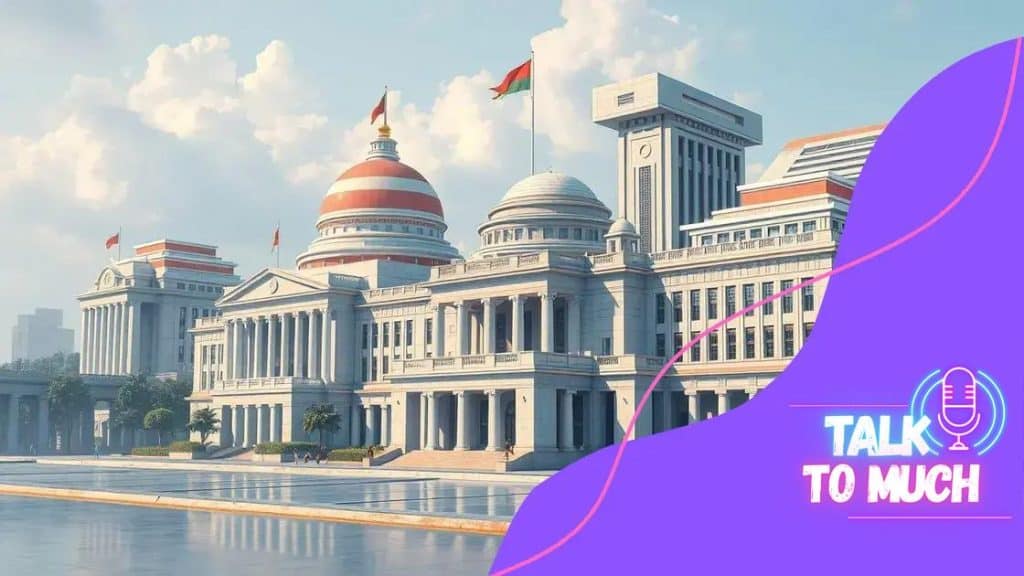Government restructuring of Project 2025: what will happen from now on

Anúncios
Project 2025 government restructuring focuses on enhancing efficiency, citizen engagement, and transparency in public services through technology integration and systematic changes within government operations.
Project 2025 government restructuring is set to change how we interact with our government.
Have you ever wondered how these shifts will impact your daily life? Let’s dive into the specifics.
Anúncios
Understanding Project 2025: Key Objectives
Understanding Project 2025 is crucial as it lays the groundwork for significant transformations in government operations.
This initiative aims to enhance efficiency, transparency, and service delivery while ensuring that citizens remain at the heart of government decisions.
One of the key objectives of Project 2025 is to streamline processes within government agencies.
Anúncios
By adopting technology and innovative practices, the goal is to reduce bureaucracy and improve response times for citizens.
By harnessing data analytics, agencies can better anticipate public needs and allocate resources effectively.
Enhancing Service Delivery
Moreover, this project emphasizes a robust approach to service delivery. With a focus on digital transformation, Project 2025 seeks to:
- Implement user-friendly online platforms for public services.
- Increase engagement through social media and mobile applications.
- Develop a feedback system to continually improve services.
Transitioning to digital platforms not only makes it easier for citizens to access services but also fosters greater accountability among government officials.
Promoting Citizen Involvement
Another critical aspect is the promotion of citizen involvement in governmental processes. This project encourages communities to voice their opinions and contribute to policies that affect their lives.
By facilitating town hall meetings and online forums, Project 2025 aims to bridge the gap between people and their government.
Understanding the objectives of Project 2025 is essential for anyone interested in how governmental restructuring can lead to improved governance.
As this initiative unfolds, it promises to redefine the relationship between citizens and their government, paving the way for a more engaged and responsive administrative system.
Impact on Government Workforce
The impact on the government workforce due to Project 2025 is significant and multidimensional.
This initiative aims at reshaping how public servants work and interact with citizens. As technology evolves, so do the roles and responsibilities of government employees.
One of the primary goals is to enhance the efficiency of government operations. This means that employees will need to adapt to new technologies and methods.
By embracing automation and digital tools, the expectation is that routine tasks will become quicker and more accurate.
New Training Programs
To support this transition, specialized training programs will be implemented. These programs are designed to help employees:
- Understand new technologies.
- Develop skills in data analysis.
- Enhance communication with the public.
By investing in training, Project 2025 ensures that the workforce is well-prepared for changes ahead.
Workforce Restructuring
As part of this initiative, the structure of teams within government agencies will also be re-evaluated.
Collaboration and cross-departmental teamwork will become increasingly important. This means that employees might find themselves working with colleagues from different areas more frequently.
Additionally, the emphasis on a citizen-centric approach will drive changes in job roles. Employees will need to focus more on public engagement and feedback, ensuring that services meet the needs of their communities.
Overall, the impact on the government workforce from Project 2025 is profound. By fostering a culture of innovation and continuous learning, government employees can better serve the public.
How Restructuring Affects Public Services

Restructuring under Project 2025 brings about important changes in how public services are delivered.
As the government shifts its framework, the emphasis is placed on efficiency, accessibility, and responsiveness. Understanding these dynamics helps us see what to expect in the coming years.
One significant change is the integration of technology in public service delivery. By digitizing processes, the government intends to make services more accessible.
This allows citizens to access resources online rather than navigating through traditional methods. As a result, wait times are expected to decrease, and services will become more user-friendly.
Improved Accessibility
Enhancing accessibility is a top priority of Project 2025. Initiatives designed to improve public services include:
- Creation of online portals for essential services.
- Development of mobile applications to facilitate engagement.
- Increased availability of information in multiple languages.
These steps aim to ensure that all citizens can benefit from government services, regardless of their situation.
Greater Accountability
Another potential benefit of this restructuring is improved accountability among government officials.
By implementing feedback systems and transparency measures, the aim is to build trust between citizens and public servants.
Engaging the public through surveys and community forums allows for constant improvement in service delivery.
Moreover, with a focus on performance metrics, government agencies will be better equipped to assess their effectiveness.
This tracking ultimately enhances public trust and ensures that services meet the needs of communities.
The impact of restructuring on public services is profound and multifaceted. As we embrace these changes, we can anticipate a more responsive and effective government that prioritizes citizens’ needs.
Challenges in Implementing Changes
Implementing changes through Project 2025 is not without its challenges. While the goals are clear and promising, the pathway to achieving them can be complex. Understanding these challenges helps us prepare for what lies ahead.
One of the primary challenges is resistance to change within the government workforce.
Employees may feel uncertain about new technologies, processes, or shifts in responsibilities. This discomfort can lead to a lack of motivation and hinder progress.
Managing Resistance
To effectively manage resistance, it is essential to provide support and resources to employees. Strategies include:
- Offering comprehensive training programs.
- Encouraging open communication about concerns.
- Involving employees in decision-making processes.
By doing this, it becomes easier to promote a culture of adaptability.
Overcoming Technological Barriers
Another significant challenge stems from the need for updated technology. Not all government agencies may have the necessary infrastructure to support new systems.
This can result in delays and frustration. Ensuring that all departments have access to reliable technology is essential for the success of Project 2025.
Additionally, there are inherent risks involved in technology adoption. Security concerns and the potential for system failures can create hesitation among public servants. It is crucial that steps are taken to address these risks effectively.
Finally, further funding is often required to carry out these initiatives. Budget constraints might limit the scope of changes that can be implemented. Prioritizing funding for key areas can help to alleviate this challenge.
Overall, although there are numerous challenges in implementing changes through Project 2025, addressing them with thoughtful strategies ensures progress towards a more efficient government.
Future Outlook and Citizen Engagement
The future outlook for citizen engagement in the context of Project 2025 is optimistic and transformative.
As the government adopts new policies and technologies, public participation is expected to rise significantly.
This shift is crucial for ensuring that the needs of the community are met and that government actions remain transparent.
One key aspect is the use of digital platforms that facilitate communication between citizens and their government.
By utilizing social media, online forums, and mobile apps, governments can reach a broader audience and encourage feedback. This new level of engagement allows for a more inclusive democratic process.

Enhancing Communication Channels
To improve citizen participation, various strategies will be put in place:
- Implementing user-friendly digital tools for submitting feedback.
- Hosting virtual town hall meetings to discuss community concerns.
- Encouraging collaboration through community projects that involve citizens.
These efforts will ensure that residents feel heard and valued, strengthening their connection with local government.
Empowering Citizens
Furthermore, Project 2025 aims to empower citizens by providing them with the information they need to engage effectively.
Transparency will be prioritized to help the public understand government actions and decisions.
This means making data readily available and easy to interpret, allowing people to make informed contributions to discussions.
As citizens become more informed, their participation will likely lead to increased accountability among public officials.
This will create a dynamic where government responsiveness becomes the norm, rather than the exception.
The future of citizen engagement, driven by Project 2025, promises a more connected and involved community.
In summary, Project 2025 is set to transform governance and enhance public services through strategic restructuring.
By focusing on technology integration, improved citizen engagement, and addressing challenges, the government aims to create a more efficient and transparent system.
The commitment to empowering citizens and fostering collaboration will lead to a stronger relationship between government officials and the communities they serve. With these changes, we can anticipate a brighter and more connected future.
FAQ – Frequently Asked Questions about Project 2025 and Government Restructuring
What is the main goal of Project 2025?
The main goal of Project 2025 is to restructure government operations to improve efficiency, transparency, and citizen engagement.
How will technology be integrated into public services?
Technology will be integrated through digital platforms for service delivery, making access easier and response times faster.
What challenges might arise during the implementation of changes?
Challenges include resistance from employees, technological barriers, and the necessity for additional funding to support new initiatives.
How can citizens engage with the government under this project?
Citizens can engage through online platforms, feedback systems, and community projects that encourage participation and collaboration.





